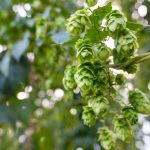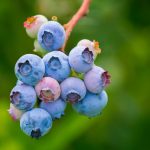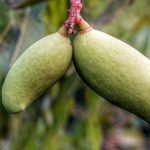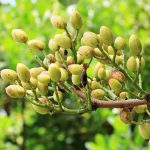
Yielding and RIGHT CULTIVES: ALMENDRO
In 2018, Spain was the third largest producer of almonds in the world, reaching a harvest volume of 4%, with the United States the first, since it represents 80%. This has its advantages, since its cultivation models can be taken as a point of reference for those considering starting out. Despite what might be thought, the area dedicated to the cultivation of almonds is much greater in Spain. The productivity difference is due to California’s intensive, highly technical and irrigated production system. Unlike pistachio, whose popularity is a trend and therefore its evolution over time is unknown, the almond market is much more stable today. However, it must be borne in mind that the market may change from one moment to the next, i.e. it is not possible to know exactly what is going to happen beyond predictions.
General characteristics
The almond tree (Prunus dulcis) is a deciduous tree, belonging to the family of the rosaceae, little leafy, usually erect, although some are more or less open. Within this species a classification of three taxonomic groups can be made, which are Communis (common almond), Amara (bitter almond) and Fragilis (mollar almond). The almond trees differ from the rest of the species of the genus Prunus by their size and elongated leaves, although the main distinguishing characteristic are the green fruits, which differ in complex from the showy coloured fruits, such as red and purple, typical of this genus.
It has a not very vigorous trunk, whose bark is smooth and greenish when the plant is younger, becoming rough and cracked, of darker tones as it develops. The branches may or may not have thorns and the leaves are elongated, narrow and pointed, with toothed limbs. The width of the leaves as well as their arrangement on the stem help to distinguish the different varieties.
The root system is adapted to the conditions of a dry climate, i.e. it is powerful, sparsely branched and has a good anchorage. The roots are quite lignified, which means that most of the water in the cell membrane has been replaced by lignin, leading to the hardening and increase of lignin volume. When starting a culture it is necessary to keep in mind that they do not have a high tolerance to transplants.
The buds can be classified into terminal or apical, arranged at one end of the branch and axillary or lateral, which, as their name suggests, are located at the lateral of the stem. The apical buds are always vegetative, so they never flower and are related to the longitudinal growth.
The flowers are hermaphrodite and self-sterile, so in order to guarantee the durability of the crop, two individuals with pollen compatible at a physiological level and, of course, with the same flowering season are needed. In other words, they need what is known as fertilization or cross-pollination, for which the action of pollinating insects is key, since contrary to what happens with pistachio, the action of the wind is not sufficiently effective.
Environmental conditions
With regard to temperature, it should be mentioned that the almond tree is a cryophilic species, which indicates that it depends on the cold in order to escape from winter dormancy. In short, a final calculation of between 169 and 713 hours of cold, below 7 °C, is needed to ensure the correct completion of the cycle. The breadth of the hour range is due to the diversity of varieties, each of which requires a specific number of hours. Likewise, the hours of heat before the flowering are essential, the duration of which must be between 470 and 1100 hours. The combination of hot and cold hours therefore determines the flowering date. Regarding the development and growth of the tree, the optimal temperature is between 18 and 32 °C, thus being one of the species with the greatest tolerance to high summer temperatures. The characteristic symptoms of heat strokes, such as dehydration of the soft tissues (leaves), are hardly apparent in the almond tree. However, in cases where temperatures exceed 35 °C, photosynthetic activity may be seriously compromised, and may even trigger a vegetative stop state, in order to withstand this adversity without causing serious damage to the tree. The main limiting factor with respect to temperature are late frosts, which directly affect flowering.
As for the rainfall, it is important to note that they should not occur during the fructification period, since when the fruit is open, it is possible that the seed will become rotten. They are also able to tolerate hot and dry summers, i.e. water is not a very limiting factor.
The most suitable soils for almond cultivation are alkaline and sandy soils, so this species has a low tolerance to saline soils, especially those with high concentrations of sodium chloride. The depth of the soil is also another factor to take into account, since the deeper the soil, the more the expansion of the roots, which in addition to developing in depth, do so also superficially, thus making better use of aeration and rainwater. Because of their antagonism, the roots are repelled when they come into contact with each other, facilitating the exploitation of the entire volume of land. For this reason, it is recommended to establish broad planting frameworks, which do not impede the development of the root system of trees. Since they do not tolerate waterlogging, a soil with good drainage is needed.
Management
As is the case with pistachio, the most common form of almond production is rainfed, where an average of 7 kg per tree is obtained per year. If a higher yield is to be expected, an irrigated or deficient irrigation crop model is needed, yielding about 15 kg, i.e. doubling the yield. It is established that a plantation is irrigated when a supply of water is made until the needs of the plant are met. In deficit irrigation, water supplies are carried out in a more strategic way, based on the phenology of the crop, but always with quantities exceeding 1000 m3/ha/year. The objective of this technique is to ensure a high level of production with a lower water consumption than traditional irrigation systems. However, it is necessary to take into account that the establishment of an irrigated crop involves a series of expenses, higher than those of rainfed farming. The most commonly used irrigation method is drip irrigation, since it avoids water losses due to excessive accumulation.
Once the decision has been made on the system to be implemented on the farm (rainfed or irrigated), a planting framework must be designed, based on the characteristics of the environment and the availability of water, a key factor in rainfed systems, as well as the machinery to be used. For those varieties with high vigor, planting frames of 7 x 7 m or 7 x 6 m are recommended. However, in those with more moderate vigor, they can be reduced to 6 x 6 m or 6 x 5 m. It should be borne in mind that in the case of rain-fed systems the tree must have a large area available for its root system to expand in search of water. In addition, in irrigation systems, space must also be guaranteed to prevent competition for light.
Pruning
A distinction can be drawn between three types of pruning: formation pruning, fruiting and renewal pruning. The first is the one that takes place during the first years of life of the tree, until about the sixth or seventh year, when the almond tree is practically developed. Its aim is to shape the final structure you want it to have. This term also includes planting pruning, in which the roots that may be damaged or those that are too long are cut at the time when the tree is planted. From the pruning of fruit, the aim is to obtain an improvement of the production values, for which old, damaged or insufficiently productive branches are cut, favoring a substitution by younger ones. It should be borne in mind that the key is to strike a balance between optimum productivity and preservation of the quality of the fruit. Finally, renewal pruning, as its name suggests, is the pruning in which most of the tree is cut when it is very old or suffers from some type of severe pathology, thus trying to rebuild the structure from the cross. It is not advisable to do it drastically, as this could lead to stress.
Plagues and diseases
Almond tiger (Monosteira unicostata): heteropterous insect with an oval shape and a grayish brown color, with a series of spots in darker shades. The appearance of the larva is very similar to that of the adult, although smaller and without wings. During the winter, in an adult state, it remains under the bark of the trees or among the undergrowth, to later recover its activity during the spring, at which time it begins to occupy the leaves. The laying of the eggs is carried out by the female, introducing the eggs on the underside of the leaves, in an area close to the main nerve. Once the nymphs emerge from the eggs, they go on to form colonies on the underside of the leaves, where stings can be seen. The maximum population usually coincides with the month of August, the point at which the third and last generation is reached before the return of the cold. The symptoms can be observed on the leaves, where yellowish discoloration occurs, to finally dry up, giving rise to pronounced defoliation when the level of infestation is very high. On the underside, excrement can be seen as small black dots, as well as remains of molts.
Green mosquito (Jacobiasca lybica): species of hemiptera, whose light green adults have an elongated shape, with translucent wings. The larva has a similar appearance, although white, which over time evolves to yellowish tones, always retaining the characteristic elongated shape. From the first nymph stage is when the wings begin to appear. Depending on the phase in which the attack occurs, one type or another of symptoms will be triggered. If it occurs in the early stages of shoot development, it will affect the terminal leaves, giving rise to discoloration and marginal desiccation, the severity of which will be more or less pronounced. If, on the other hand, the attack occurs in more advanced stages, the symptoms will be observed in the already formed leaves.
Green aphid (Myzus persicae): Homoptera of variable color, from practically colorless to pink, although as a general rule it usually acquires a yellowish-green coloration. The length of the antennae tends to be the same as that of the body. In their life cycle, the females, which reproduce asexually by parthenogenesis, reach their maximum population during the spring season, to later decrease in summer, increasing again in autumn. When the cold arrives, they reproduce asexually, giving rise to eggs, which are deposited in the host and whose form is the most resistant to winter conditions. In areas where winters are milder, it is not necessary for it to spend the winter in egg form, so that adults and nymphs can be found throughout the year. The damage it produces is due to the fact that the sap is its food source, which is why it produces a generalized weakening of the plant. In addition, the leaves are curled, that is, they roll up on themselves. The secretion of molasses favors the colonization of the leaves by a pathogenic fungus, which forms a black layer on them, thus reducing photosynthetic activity.
Mealybug (Hyalopterus amygdali): polyphagous insect whose main host is the almond tree, although during the months of higher temperatures it can move to other host plants, which means that it has a dioecious cycle. The adult is wingless, that is to say, it does not have wings, it is pale green in color and is covered by white, floury-looking waxy secretions, which give it its name. The green nymphs are also covered by these secretions, located mainly on the legs and antennae. Like the green aphid, they spend the winter in egg form and due to the suction of sap by the colonies, the longitudinal curling of the leaves. When migration to secondary hosts occurs, asexual reproduction occurs by parthenogenesis.
Shoot and fruit miner (Anarsia lineatella): Lepidoptera, whose larvae spend the winter in different holes, inside the bark of trees or in small holes dug previously by them. They protect these cavities with remains of bark and silk threads. When the temperatures begin to be higher, the larvae go outside, subsequently entering the interior of the buds. Completed its development, it pupa inside a silken cocoon, from which the first adults emerge approximately at the end of spring. When reproduction occurs, the female lays the eggs, from which the caterpillars emerge that attack the fruits, digging galleries inside them. The damage they produce in the almond tree is less than in other fruit trees, as is the case of the peach tree, since the damage occurs fundamentally in the pulp of the fruit and the usable part is the seed. It can cause a premature fall of the fruits, due to an acceleration of the ripening process.
Orugueta (Ectomyelois ceratoniae): polyphagous lepidopteran insect, also known by the name of barreneta. Adults have a dark gray color on the body and wings, which also have a series of angular and sinuous black spots. The caterpillars, on the other hand, have a pink color and a brown head. The eggs, which are laid by the female, are arranged in the fruit, more specifically at the point where the two parts of the outer shell of the almond meet. Once the larvae emerge, they penetrate the fruit through a hole, placing themselves between the inner and outer shell, on which they feed, and can also reach the seed. Soft-skinned varieties, that is, those that can be peeled more easily, are the most sensitive to this pest. When the fruits are green, it is possible to distinguish a series of threads and a kind of sawdust in its navel, which correspond to the droppings of the larva. However, over time this disappears, making the attack practically imperceptible.
Yellow and red spiders (Eotetranychus carpini, Tetranychus urticae and Panonychus ulmi): Tetranychid mites, of which the first two develop on the underside of the leaves, while the red spider does both on the underside and on the upper side. E. carpini and T. urticae are very similar in appearance, as they are both yellow in color and oval in shape. However, they show some differences, since E. carpini has dark spots on each side of the body, while T. urticae only has a larger dark spot on each side. During the course of the winter, although both remain in their adult form, the first takes refuge in cracks and in the bark of the tree, while the second does so in the vegetal cover. They resume their activity in spring and have several generations, which form colonies in areas close to the nerves of the leaves, where they feed. P. ulmi overwinters as an egg, laid out on the trunk and branches of the tree. It differs from the previous species since it has a reddish coloration, in addition to hairs on the dorsal area, which are known as quetas. Due to the bites made by the mites, there is a discoloration on the leaves. In the case of yellow spiders, the coloration of the leaf turns yellowish, while when the attack is caused by the yellow spider, the color progressively loses intensity and reaches a matte hue. They can trigger serious defoliation that endangers the proper development of photosynthetic activity.
Waspilla (Eurytoma amygdali): species of hymenopteran with a thin and elongated body in dark tones, which only have one generation per year, of great relevance, since it can cause losses of up to 90% of the harvest in those varieties that are more susceptible. They present sexual dimorphism, so that the females are larger than the males. During the course of winter they are found in the larval stage inside the shell of the fruit. Affected almonds remain mummified on the tree until spring, even after harvest. The laying of the eggs is carried out by the females, who dispose them inside the freshly set fruit. The larva that emerges from the egg feeds on the seed until the arrival of summer. The symptoms of this pest include a change in the color of the almonds that turn gray and take on a dehydrated appearance.
Big-headed worm (Capnodis tenebrionis): black beetle with gray spots in the adult stage, which during the winter stays close to the tree, generally on the ground, to climb to the top of the trees during the spring, where they feed of the shoots. The female lays her eggs on the ground during the summer months, near the trunk. The larvae are the ones that cause the most serious damage, because they dig galleries from the roots, ascending little by little, causing a progressive weakening, which leads to a decrease in production. It is possible to find larvae from the previous year inside the wood, that is, they are in a different stage of development. If the attack is very strong, it is possible that the tree will die. All trees that have been affected are more susceptible to attack by other pests.
Almond caterpillar (Aglaope infausta): belonging to the order Lepidoptera. The caterpillars, which are dormant during the winter, begin to appear once the sprouting of the host plant has begun, at which point they can begin to feed on the buds and the most tender leaves. This activity is maintained until mid-spring, when they reach the level of full development. Then the chrysalises from which the butterflies emerge, whose main function is to reproduce, are formed. The laying of the eggs takes place in the hollows of the bark. Once the caterpillars belonging to the next generation come out, they stay for a short period of time feeding, to later spend the hottest months in summer and coldest in winter sheltered. During the first stages, the larvae resemble a grayish earthworm, and later they acquire the striking hues that characterize this species. They have purple bumps with protruding hairs, which can cause contact reactions.
Green almond caterpillar (Orthosia cerasi): Lepidoptera whose adult is a butterfly with wings that vary in color from gray to orange-brown, with two large stigmas as its most distinctive feature, while the caterpillar is green and finely mottled . The symptoms of this plague begin to appear in spring, at which time adults emerge from the chrysalises, which have spent the whole winter in the ground. This is followed by the laying of the eggs on the tree and their subsequent hatching. The larvae are the ones that cause the most serious damage, since they feed on the almonds, which have not yet hardened. The same larva can even feed on several fruits, so that in the event of a massive attack, production levels can be considerably reduced. They have a single annual generation.
Fruit borer (Ruguloscolutys (Scolytus) amygdali): beetle with a cylindrical body, dark in color, in its adult phase. Contrary to what happens in some species, it does not present a very pronounced dimorphism between the male and the female. Two generations occur in the same year. During the winter the larvae take shelter in the nest, which is generally located under the bark. The first emergence of adults, after a stage of nymphosis, occurs in the months between May and July, followed by a second that occurs in the month of August, more specifically in the middle. The female digs a gallery in the bark where she lays her eggs, from which the larvae will emerge, which in turn will drill new galleries, which gradually widen as they develop, ending in what is known as a cell. nymphal For the construction of these tunnels, the females opt for those trees that present a greater vegetative vigor. The damage they produce is due to the feeding holes of the adults, in young shoots and buds and those associated with the creation of the previously mentioned breeding galleries. Due to this there is a weakening of the tree.
Root-knot nematodes (Meloidogyne spp.): as their name suggests, they are internal gall-forming parasites, that is, tumor-like structures induced in response to their presence, with abnormal growth with which the tree tries to isolate attack or infection. Also, females are considered as sedentary endoparasites. Its cycle begins with an egg, in which the first phase occurs, thus reaching the infective stage, which will enter the root calyptra, disposing in areas close to the vascular bundles, which are a strategic point in which they have food guaranteed. Next, three more molts are produced, thus originating the adults. At this stage it presents a clear dimorphism, since the females acquire a globular shape, while the males maintain a more vermiform shape.
Monilia or brown rot (Monilinia spp.): ascomycete fungi considered one of the most relevant pathogens, due to the significant economic losses associated with it. It is characterized by forming a pseudostroma (hyphal compaction), generally flat, which triggers the formation of spore-bearing fructifications, which can be sexual or asexual. The latter are the most common. In the winter season they remain mummified in the fruits, in the infected tissues of the branches, the peduncles of the fruits or the cankers of the branches. Among the symptoms that characterize its infection are the burning or drying of the flowers, produced by the infection through spores; the burning or drying of shoots and young branches, as a consequence of the infection through the affected flowers, which reaches the bark of the branch through the peduncles of the fruit, beginning to appear brown spots that collapse the area, causing a loss of turgor, which gradually spreads; the formation of cankers, due to the entry of the fungus through previous cold injuries or pesticide treatments, among others; and, finally, the rotting of the fruits, which is the most serious symptom and is also caused by infection through the initially contaminated flowers. When the fruits are green, they show greater resistance to infection, which is lost as they ripen. Although the infection begins superficially with the appearance of brown spots on the surface, the seed, if affected, will end up rotting or losing its ability to germinate.
Screened or perdigonado (Coryneum beijerinckii): fungus whose attack occurs in different areas of the tree, such as leaves, fruits and branches. During the months with higher temperatures, this species remains in a state of inactivity, and then moves on to a second, more active phase in autumn, when temperatures drop and the degree of humidity in the environment increases. In winter the fungus remains in the scales of the affected buds or in the puddles in the form of mycelium. When spring begins, sporulation begins from these points. The spores are dispersed by the action of rain and wind, which is why in springs with a higher rate of precipitation, propagation increases. Symptoms can be seen at all infected sites, where red-brown spots appear, eventually becoming necrotic. On the leaves, these spots dry up and fall off, giving rise to the perforations that give this pathology the name of birdshot. Severe attacks produce defoliation, which can even reduce photosynthetic activity.
Leprosy or dent (Taphrina deformans): parasitic fungus also known as Exoascus deformans, which mainly affects the leaves. Its life cycle is characterized by presenting different changes in terms of morphology. At first, they are saprophytic unicellular fungi, which become filamentous fungi, a phase that represents the parasite state. It has the ability to remain during the winter in the form of ascospores on the surface of the plant, thus remaining dormant until the arrival of spring. The symptoms, given that the affectation occurs in the leaves, are the appearance of yellowish dents, which end up acquiring reddish tones and end up being completely deformed. These deformations are due to a stimulation of the level of cell growth and division, above the values considered normal. A whitish fuzz appears on the underside of the leaves, more noticeable as the infection progresses.
Ocher spot (Polystigma ochraceum): pathogenic fungus that leads to early defoliation of the tree, which coincides with the summer months, due to high temperatures and water needs. As a consequence, the harvest is affected, since the capacity to carry out the photosynthetic function is lost, thus preventing the storage of reserves for the subsequent fruit setting. This affectation occurs in spring, through sporulation, after a winter in which the fungus continues to evolve, once the leaves have fallen to the ground. The symptoms appear, therefore, on the leaves where brown spots are formed that change to reddish tones in summer. Over time, the spots will eventually become necrotic, after an increase in thickness.
Canker (Phomopsis amygdali): fungus whose infection spreads in the spring months, when rain, dew and high humidity cause a drip that drags the spores from one shoot to another. This favors infection in the lower part of the tree canopy. Infections may also occur in the fall, during leaf fall. The most characteristic and visual symptom is the desiccation of the shoots that have been affected. If the attack is very severe, it is possible that the entire lower part of the tree will dry up, which gives it an easily distinguishable appearance. Oval brown cankers form on affected branches and spread around the buds. They can be confused with those caused by monilia (Monilinia spp.), previously described. The fungus also produces a toxin that, during its transport through the sap, triggers the closing of the stomata, thus drying the shoots downwards. Leaf necrosis is not common.
Anthracnose (Colletotrichum acutatum): pathogen, whose presence is infrequent in traditional cultivation areas, although, given the necessary climatic conditions, it can become highly relevant. In the most unfavorable times it remains mummified in the fruits or in the form of mycelium in the wood and in shoots. During fruit setting is when the first infections begin, coinciding with the arrival of more favorable temperatures and increased rainfall. It affects flowers, fruits, leaves and buds, although the most common symptom appears on the fruits, where circular, slightly depressed, orange lesions are formed. At the beginning of the development of the pathology, the shoots and branches with infected fruits show yellowness and desiccation in the leaves. It is believed that the death of the branches, as well as the desiccation of the leaves, is due to the production of toxins by the fungus.
Rust (Tranzschelia pruni-spinosae): basidiomycete fungus, which can only complete its cycle in two different hosts, which correspond to herbaceous plants in the first phase, continuing with woody species. Even so, it is not one of the most important pathologies, since it usually occurs more sporadically, although under high humidity conditions more severe damage can occur, giving rise to high defoliation. Infection of new leaves occurs in the spring, so the pathogen must be maintained as resistance spores on fallen leaves or as mycelium on affected branches, during months with less favorable conditions. Its presence is easily detected on the upper side of the leaves, where numerous small, yellowish spots appear. Brown pustules form on the underside, which are the ones that contain the spores.
Verticillium wilt (Verticillium dahliae): disease caused by the action of the pathogenic fungus that gives it its name, which leads to discoloration and rolling of the leaves. It can even cause the death of the tree, since its branches gradually dry out. Its transmission can occur between trees of the same species or by contagion through a host, such as adventitious species and other species cultivated in adjoining areas. The fungus infects the tree through the roots, taking advantage of lesions on its surface produced by work carried out by the farmer or by the action of other living beings, such as insects or nematodes. Once it has reached the interior, the mycelium of the fungus spreads, relatively quickly, through the vascular system, producing a reaction to the viscous substances produced by the pathogen, which clog the conductive vessels.
Neck rot (Phytophthora spp.): genus that encompasses different species, all of them oomycetes, which cause wilting and can remain in the soil for several years, in the absence of a host, especially in the most superficial layers , in organic substrates such as plant remains and humus. The factors that most favor its development are high temperatures and excess water. In winter it is located in the roots, tubers and infected bulbs or in the soil, in different forms. Its transmission occurs by wind and rain, which causes it to fall to the ground, where it spreads, which is why its highest incidence occurs in irrigated areas. It enters the host from unprotected surface wounds or natural openings. The symptoms are concentrated in the neck and the main roots, which rot and the bark dehydrates, thus taking on a dark color. The disease progresses relatively easily and the trees that suffer from it present generalized weakening, leaf fall, wilting, small-sized fruits and poor maturation, collapse and even death. All these symptoms depend on the severity and level of involvement.
Root rot (Armillaria mellea): fungus that can be pathogenic for certain species, such as the almond tree, but that is edible for humans. As the common name indicates, it causes root rot, although the main symptoms are observed in the treetops and, of course, in the wilting and even death of the branches. In short, it causes the death of the plant due to the loss of its ability to absorb, through the roots, the nutrients and water necessary for its survival. It is common in crops arranged on compact, heavy and humid soils that tend to suffocate roots and in young plantations that settle in areas with previous forestry use. In the roots a change of color begins to take place, becoming more brown and later a blackening of the bark is reached. All those tissues where the parasite expands will disintegrate, transforming into a fibrous mass. When the infection reaches the roots near the neck, it may progress upwards towards the base of the trunk, where a lesion appears, which manifests itself with exudations of sap or gum.
Bacterial spot of stone fruit trees (Xanthomonas arboricola): species of proteobacteria, whose symptoms can be confused between different species, as well as with those of other bacteria or fungi, among others. Although given optimal conditions, no variety is resistant, if there are different sensitivities, that is, trees with very severe symptoms can be seen next to others with milder symptoms. Latent infections may also occur, which means that although the tree is infected, symptoms are not triggered. Stains appear on the leaves delimited by secondary nerves, which can be seen both on the upper and lower sides, leading to a yellowing of the leaves. There is also significant defoliation. In the fruits there are spots surrounded by a yellow halo, which with the passage of time become necrotic, producing the emission of gum.
Gall or neck tumor (Agrobacterium tumefaciens): proteobacteria, also called Rhizobium radiobacter, which triggers the formation of tumors known as galls, which grow mainly in the area where the roots and the stem meet, that is, in the neck. The pathogen reaches the small wounds through which it enters, guided by the phenols that the plant expels. It can survive in the soil as a saprophytic organism for years, feeding on different decomposing materials. In the fall and winter it ceases its activity, resuming it when conditions are more favourable. The symptoms of this disease mean that it can be confused with damage caused by root diseases caused by fungi, such as Armillaria mellea, or due to nutritional deficiencies. The only external symptoms that can be observed are around the neck. The progressive weakening of the tree is related to the difficulty in circulating the sap, which can even cause the death of the plant. The most important losses occur in nurseries, since young plants are much more vulnerable.








